Net-Zero Hero: Susan Ashworth

I’m helping to make Austin Net-Zero by encouraging the use of native plants and flowers.
From bluebonnets to primroses to firewheels, our fields and highways are starting to bloom in color. Central Texas is currently in peak wildflower season, and according to the Wildflower Forecast from the Lady Bird Johnson Wildflower Center, 2024 could be a banner year for wildflowers.
One person who will be celebrating: Susan Ashworth, wildflower advocate and our newest Net-Zero Hero. Susan is a longtime Austinite and retired social worker who now spends her days gardening, supporting local community groups, and volunteering. Through her volunteer positions with the Tarrytown United Methodist Church’s United Women in Faith group and the Austin Woman’s Club, Susan takes every opportunity she can to promote sustainable practices and create a greener Austin, with a particular focus on native Texas landscaping.
We met with Susan at her home to talk about her love of native plants, work in the community, and favorite places to view wildflowers (you might be surprised)!
What inspired you to take action?
Several years ago, when driving home from my hometown, Lamesa, in West Texas, I found myself admiring the native grasses. I realized I would never live there again, but perhaps I could re-create that landscape here in Austin in my own yard. I found the grasses and plants and flowers beautiful and just so “right.” My yard, by comparison, seemed boring and ugly. So, I got to work — not fully realizing what it would take to turn a 0.4-acre lot into an urban prairie.

Susan admires yellow petunias at her home today.
Growing up on the South Plains, I realized how precious water is and I have always been mindful of my use. This also added to my conviction that a native Texas landscape was the way to go.
How did you do it?
I began by realizing I knew practically nothing about turning my yard into a native Texas habitat and landscape. One Sunday morning over twenty years ago, I was listening to John Droomgool’s gardening show on KUT. With this new mission in mind, I felt compelled to call in. I asked John how to begin, and he recommended Elizabeth McGreevy as a resource. So, I contacted Elizabeth, and we started on our journey of reclaiming my yard. It was a process — a rather long one — but so rewarding.
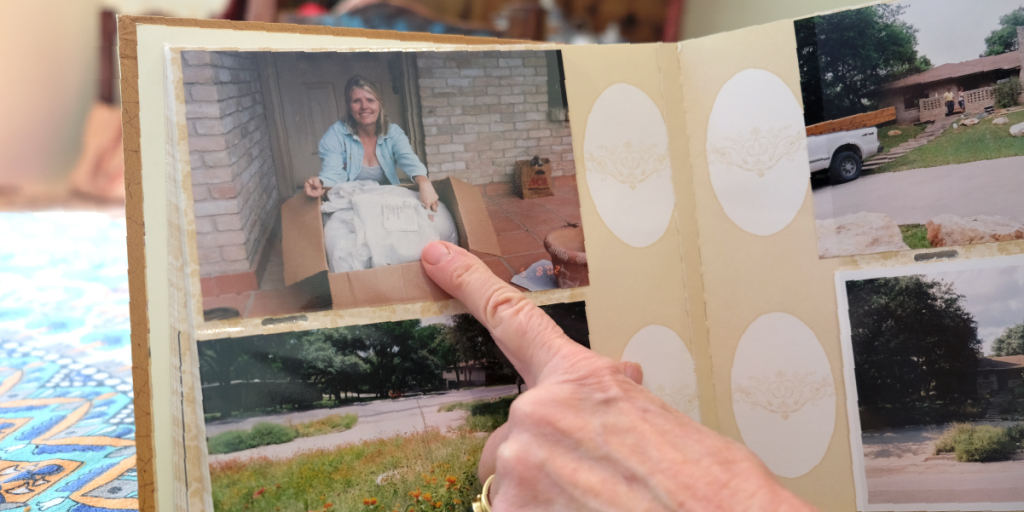
Susan remembers how excited she was to receive the box of seeds she ordered from a company focused on native landscaping.
I’ve since sold that home, but the lessons I learned remain. I’ve worked on incorporating native practices at my new home. My husband is more of a traditionalist when it comes to yards, so it is definitely a give-and-take. I have planted native plants wherever I can. A recent edition is Texas Sage. It’s wonderful to see the wildlife coming through — nothing like what you find in a fully native landscape — but we have deer, skunks, foxes, raccoons, and armadillos all passing through. We also have a frog pond — tadpoles hatch nearly every spring!
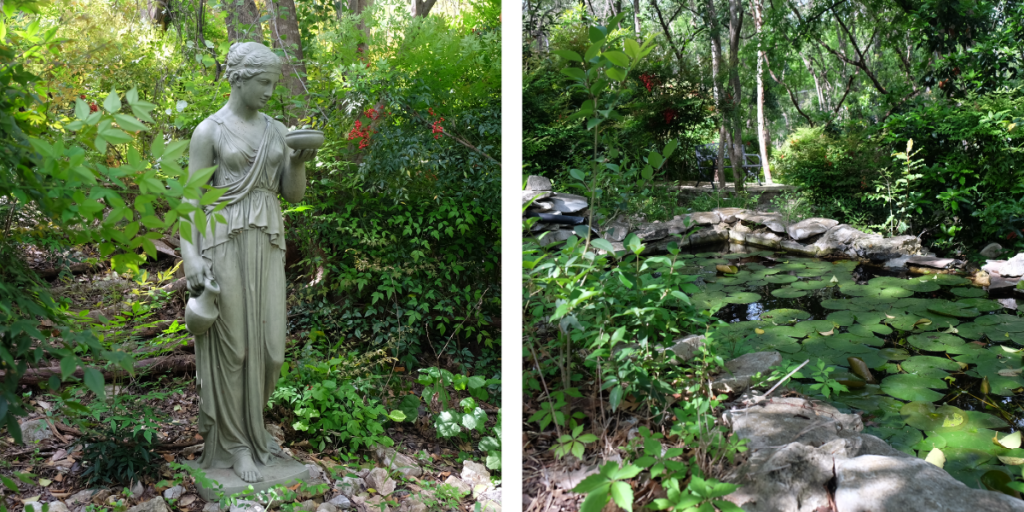
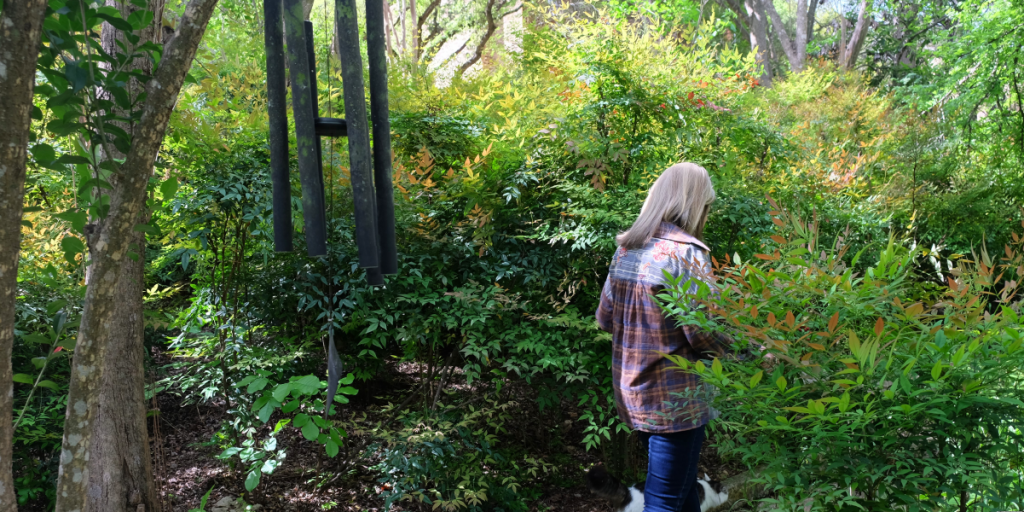
Above left: Hebe, the god of youth, watches over Susan’s gardens; above right: a pond shared by frogs and lilies; below: Susan, with her cat Punkin’ at her heels, passes by the windchimes in her garden.
I also try to share what I’ve learned however I can. I consider myself kind of like the Johnny Appleseed of wildflowers. I carry seeds in my pockets every November and scatter them on walks. In the last few years, Rollingwood Park has planted butterfly and wildflower gardens — which I help maintain with a team of other volunteers. I’ve invited speakers from the Office of Sustainability to speak with the Tarrytown United Methodist Church’s United Women in Faith group and the Austin Woman’s Club and have also organized native planting at both of these locations.
I’m grateful that I’m able to continue to spread the word about native landscapes. Little actions can have big ripples.

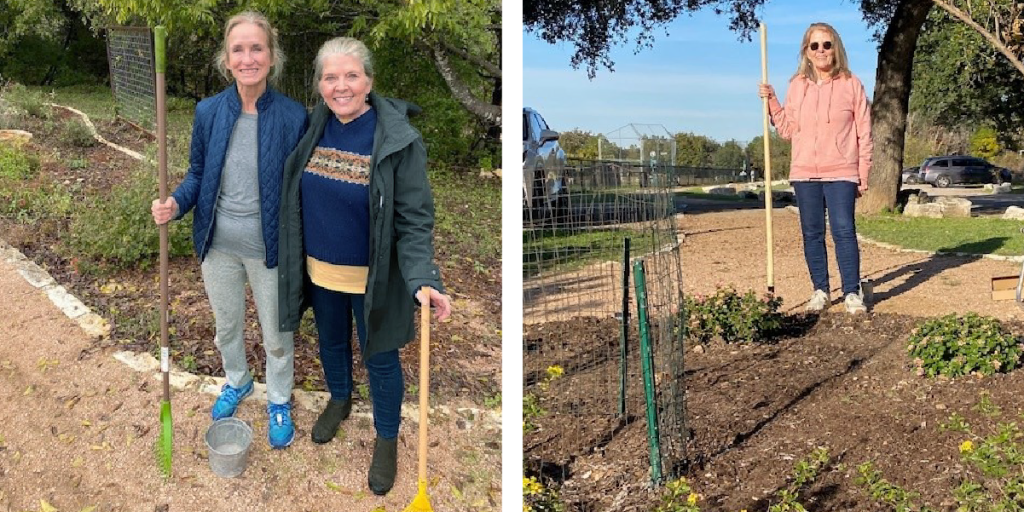
Above left: Susan and volunteers from the Tarrytown United Methodist Church’s United Women in Faith group pose with native plant beds; above right: Susan with fellow members at the Austin Woman’s Club; below: Susan on volunteer workdays at the Rollingwood Park.
What’s been most rewarding about getting involved in this way?
Well, I do think that my yard in Rollingwood was the first one to completely embrace the native look. Sure, walking around the neighborhood, you might have seen a few yuccas, cacti, and other small areas that tipped their hat to “native” — but I embraced it in its entirety!

Susan points out the many visitors to her native gardens — from lizards and caterpillars to her daughter’s boxer and Elizabeth McGreevy’s son.
I had neighbors walk by and just stop and look — and not always in an admiring way. One fellow asked me as I was weeding how I could tell the weeds from the grasses. I just smiled and said that I had studied and learned how.
Now, I see many more yards with this concept. In fact, Rollingwood City Hall has a native landscape. I think I started something that others saw, liked, and thought made sense.
I also had chickens in my backyard for a few years, which I loved. But do you know that everything wants to eat a chicken? One night, an owl got my last one, Henny Penny, from the big tree in the back. I haven’t gotten back into the chicken business since then. As absolutely charming and delightful as they are, chickens require protection, attention, and care. Still, I wouldn’t trade that experience for anything.
What’s been the toughest part?
The toughest part is the manual labor that goes into establishing the yard itself. Plus, it is not carefree. A native yard still must be groomed and maintained. However, when you’re as nuts about it as I was, I found all of it to be fun! Sometimes, when at my day job during that time, I couldn’t wait to get home to tend to the yard.
Susan's garden transformation was featured on KLRU in 2007.
I never knew that I liked botany, either. Before this experience, if you’d asked me, I would have guessed that biology would interest me more. Not now! I am absolutely fascinated with botany. Who knew?
The truly toughest part, though, was seeing my beautiful yard scraped to build a huge new home after we sold. That’s what I get for selling, I guess. No hard feelings, but I did go over the night before closing to hug my trees and say goodbye to my yard.
For anyone who may be facing this type of situation, the Native Plant Society of Texas’ Austin Chapter offers “Plant Rescues,” where volunteers help property owners rehome native plants and seeds before construction.
Our interview will come out during the height of wildflower season. What are some of your favorite wildflowers and your favorite places to view them?
My sentimental favorite is Scrambled Eggs. Why? Because in that first spring after my garden makeover, it was the very first little wildflower to peep out.
Other favorites are:
- Bluebonnets (of course)
- Wine Cups
- Antelope-horn Milkweed
- Indian Blanket
- All the Mallows: Globe, Velvet-Leaf, and Indian
- and Maximilian Sunflowers are stunning.
Perhaps surprisingly, I don’t have a favorite spot to look at wildflowers. They are abundant along the highways (thank you, Lady Bird!), and how marvelous that they are everywhere for all to enjoy.
.png)
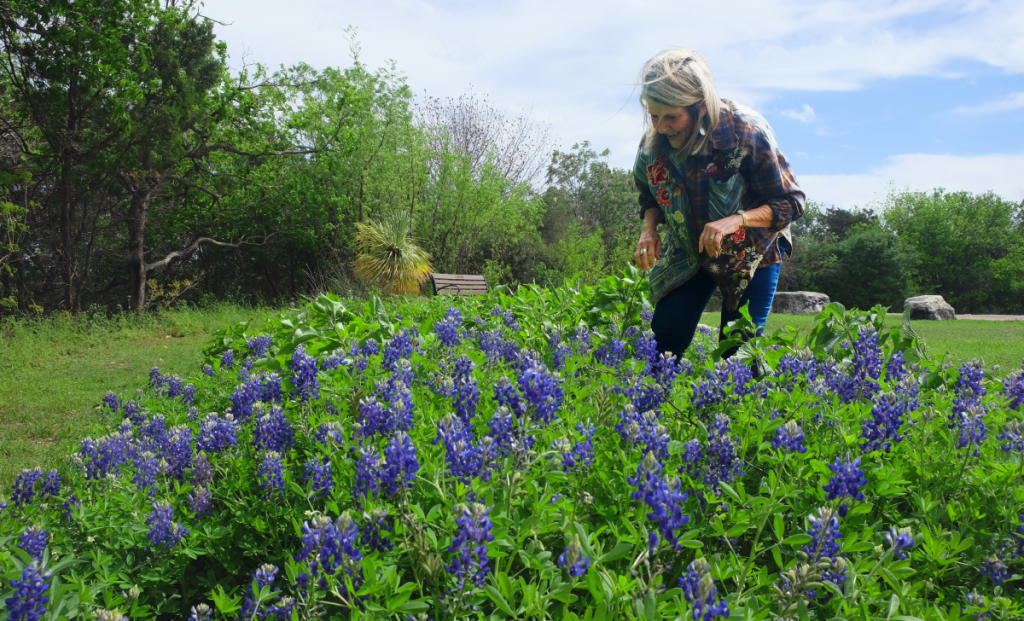
Above (from left to right): Scrambled Eggs, Winecups, Antelope-horn Milkweed, Indian Blanket; Globemallow, and Maximilian Sunflowers; below: Susan pulls weeds from a patch of bluebonnets at the butterfly garden in Rollingwood Park.
Is there a book, documentary, or other piece of media you would recommend for folks wanting to learn more about these topics?
There is so much information available. Go online, go to the bookstore, go to the library. Follow your passion. Do your homework, then put your plan in motion.
For anyone looking to start a native landscape, I highly recommend learning more about Elizabeth McGreevy’s work. She even wrote a book on the importance of Mountain Cedars that is worth a read for all Central Texans.
What advice do you have for others?
My words of advice are not necessarily about wildflowers but mostly about life:
- Pick up litter — a small act with a big impact
- Say hello and acknowledge others when you pass them
- Smile at infants and children — let them know that the world is a good place
- Be kind to all living things (Thank you, Dr. David Hawkins)
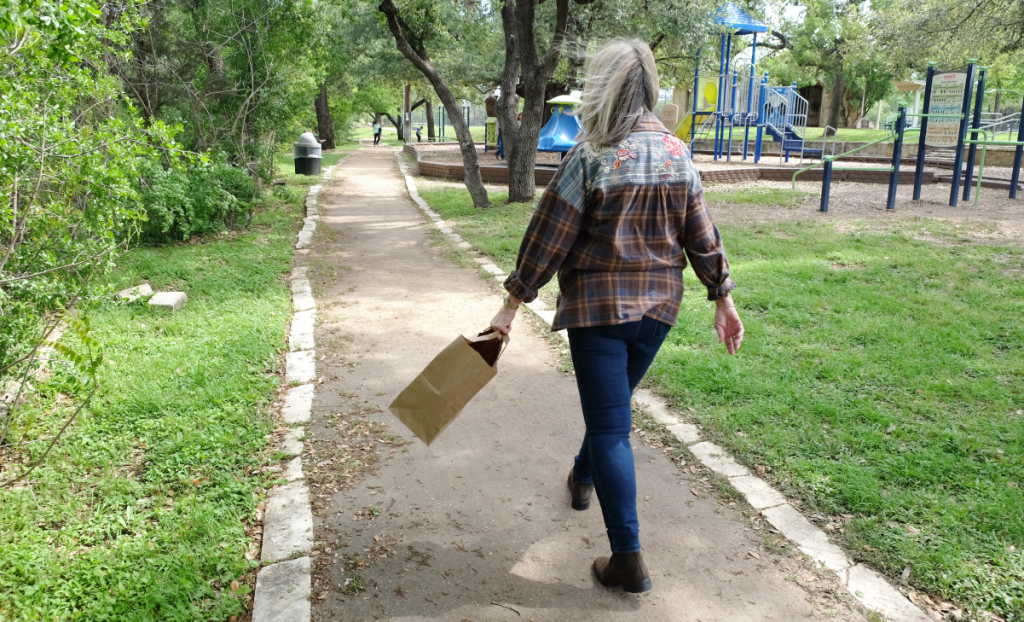
On a walk in Rollingwood Park. Susan always brings a paper bag to collect trash along the way.
Interested in planting native plants in your own yard? Explore the Watershed Protection Department’s Grow Green Resources, including their popular Native and Adaptive Landscape Plant Guide. You can also earn rebates through Austin Water for converting your lawn to native plant beds. To learn more about Austin's net-zero goal and explore actions you can take to support a greener community, view the Austin Climate Equity Plan.
Share your Net-Zero contributions with us on X (formerly Twitter) or Facebook, and use #NetZeroHero. If you know a Net-Zero Hero (or heroes!) who should be recognized for their efforts, send your nomination to sustainability@austintexas.gov.
